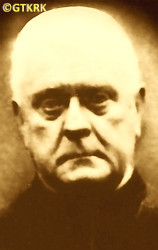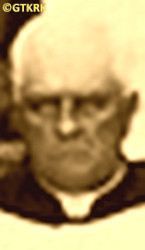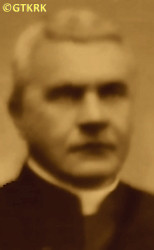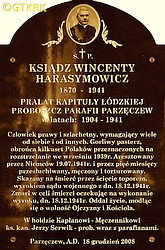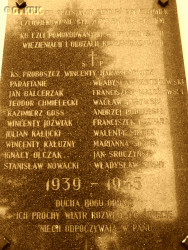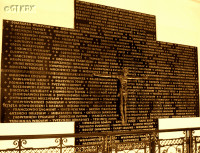Roman Catholic
St Sigismund parish
05-507 Słomczyn
85 Wiślana Str.
Konstancin deanery
Warsaw archdiocese, Poland
full list:
displayClick to display full list

searchClick to search full list by categories
wyświetlKliknij by wyświetlić pełną listę po polsku

szukajKliknij by przeszukać listę wg kategorii po polsku

Martyrology of the clergy — Poland
XX century (1914 – 1989)
personal data
surname
HARASYMOWICZ
forename(s)
Vincent (pl. Wincenty)
function
diocesan priest
creed
Latin (Roman Catholic) Church RCmore on
en.wikipedia.org
[access: 2014.09.21]
diocese / province
Łódź diocesemore on
en.wikipedia.org
[access: 2013.05.19]
Warsaw archdiocesemore on
en.wikipedia.org
[access: 2013.05.19]
honorary titles
Prelate‐curator (Lat. praelati‐custos)more on
Prelate—curator (Lat. praelati—custos)
(1936 – , St Stanislav Kostka the Confessor RC cathedral church, Łódźtoday: Łódź city pov., Łódź voiv., Poland
more on
en.wikipedia.org
[access: 2021.07.18])
Minor Canonmore on
Minor Canon
(1922 – , St Stanislav Kostka the Confessor RC cathedral church, Łódźtoday: Łódź city pov., Łódź voiv., Poland
more on
en.wikipedia.org
[access: 2021.07.18])
date and place
of death
18.12.1941

Poznańtoday: Poznań city pov., Greater Poland voiv., Poland
more on
en.wikipedia.org
[access: 2021.07.18]
alt. dates and places
of death
01‑02.1942
Łódźtoday: Łódź city pov., Łódź voiv., Poland
more on
en.wikipedia.org
[access: 2021.07.18]
details of death
After German and Russian invasion of Poland in 09.1939 and start of the World War II, after start of German occupation, arrested by the Germans on on 19.07.1941.
Jailed in Łódź prison (prob. Sterling prison) and interrogated at Germ. Geheime Staatspolizei (Eng. Secret State Police), i.e. Gestapo, HQ on Anstadta Str. Described by German investigators as Germ. „ein fanatischer Pole” (Eng. „a fanatical Pole”).
On 09.12.1941 in Łódź — after 5 months long trial — sentenced, prob. by a Germ. Sondergericht (Eng. special court), or by the Germ. Langericht (Eng. regional court) — Łódź was incorporated into the newly established German province of the Germ. Reichsgau Wartheland (Eng. Reich District Wartheland), which included occupied Greater Poland — to death by ax beheading, together with 7 other Poles, on bogus charges of arms possession and „not preventing the death of German soldier in 1939”, i.e. during German invasion of Poland in 09.1939 (case file No. 8S. KLs. 118/41).
According to witnesses, on 10.09.1939, the Polish soldiers captured a German wounded soldier, and because the German troops were fast approaching and they had to leave the village, they asked the priest to hand him over to the German army.
Before that happened, the German, treated by a priest, escaped and was captured by other Polish non–commissioned officers who shot him.
Beheaded in Młyńska Str. UH Posen Gestapo investigative jail in Poznań, where Germans in the Germ. Reichsgau Wartheland carried out death sentences.
Did not ask the German authorities for a pardon.
And there, in the death cell, was to perish. According to the death certificate, the „honest” otherwise German „medical doctors” and formalists — and at the same time, unrivaled fairy tale spinners — noted that the cause of death was supposed to be Eng. „weakening of the heart muscle”.
alt. details of death
According to some sources perished in Łódź prison, before execution, from heart attack.
According to other was beheaded in Poznań.
cause of death
murder
perpetrators
Germans
sites and events
UH PosenClick to display the description, 06.10.1941 arrests (Warthegau)Click to display the description, Łódź (Anstadta)Click to display the description, Łódź (Sterling Str.)Click to display the description, Ribbentrop‐MolotovClick to display the description, Pius XI's encyclicalsClick to display the description
date and place
of birth
19.07.1870

Cydzyntoday: Stary Cydzyn, Piątnica gm., Łomża pov., Podlaskie voiv., Poland
more on
en.wikipedia.org
[access: 2022.01.28]
alt. dates and places
of birth
07.07.1870
parents
HARASYMOWICZ Anthony
🞲 ?, ? — 🕆 ?, ?

ROCZKOWSKA Adele
🞲 ?, ? — 🕆 ?, ?
presbyter (holy orders)
ordination
29.01.1893

Warsawtoday: Warsaw city pov., Masovia voiv., Poland
more on
en.wikipedia.org
[access: 2021.10.09]
positions held
1904 – 1941
parish priest — Parzęczewtoday: Parzęczew gm., Zgierz pov., Łódź voiv., Poland
more on
en.wikipedia.org
[access: 2022.08.05] ⋄ Assumption of the Blessed Virgin Mary RC parish ⋄ Łęczyca / Ozorkówdeanery names/seats
today: Łódź voiv., Poland RC deanery — also: member of the Administrative Commission for Church Property of the Diocesan Curia (1922‐1930)
1922 – 1941
Minor Canon — Łódźtoday: Łódź city pov., Łódź voiv., Poland
more on
en.wikipedia.org
[access: 2021.07.18] ⋄ Cathedral Chapter ⋄ St Stanislav Kostka the Confessor RC cathedral church — 1936‐1941 Prelate‐curator (Lat. praelati‐custos), 24.05.1933‐1936 second canon
from 18.05.1915
dean — Łęczycatoday: Łęczyca urban gm., Łęczyca pov., Łódź voiv., Poland
more on
en.wikipedia.org
[access: 2021.12.18] RC deanery
c. 1901 – c. 1904
parish priest — Poddębicetoday: Poddębice gm., Poddębice pov., Łódź voiv., Poland
more on
en.wikipedia.org
[access: 2021.12.18] ⋄ St Catherine the Virgin and Martyr RC parish ⋄ Łęczycatoday: Łęczyca urban gm., Łęczyca pov., Łódź voiv., Poland
more on
en.wikipedia.org
[access: 2021.12.18] RC deanery
c. 1900
parish priest — Grochówtoday: Nowe Ostrowy gm., Kutno pov., Łódź voiv., Poland
more on
en.wikipedia.org
[access: 2021.03.16] ⋄ St Thomas the Apostle RC parish ⋄ Kutnotoday: Kutno urban gm., Kutno pov., Łódź voiv., Poland
more on
en.wikipedia.org
[access: 2021.12.18] RC deanery
c. 1899
parish priest — Imielnotoday: Nowe Ostrowy gm., Kutno pov., Łódź voiv., Poland
more on
en.wikipedia.org
[access: 2022.08.10] ⋄ Immaculate Conception of the Blessed Virgin Mary and St Michael the Archangel, All the Saints and St Peter and St Paul the Apostles RC parish ⋄ Kutnotoday: Kutno urban gm., Kutno pov., Łódź voiv., Poland
more on
en.wikipedia.org
[access: 2021.12.18] RC deanery
c. 1897 – c. 1898
vicar — Tomaszów Mazowieckitoday: Tomaszów Mazowiecki urban gm., Tomaszów Mazowiecki pov., Łódź voiv., Poland
more on
en.wikipedia.org
[access: 2021.09.29] ⋄ St Anthony of Padua RC parish ⋄ Brzezinytoday: Brzeziny urban gm., Brzeziny pov., Łódź voiv., Poland
more on
en.wikipedia.org
[access: 2020.11.27] RC deanery
c. 1895 – c. 1896
vicar — Wolatoday: district of Warsaw, Warsaw city pov., Masovia voiv., Poland
more on
en.wikipedia.org
[access: 2021.12.18] ⋄ St Stanislav the Bishop and Martyr and St Lawrence the Deacon and Martyr RC parish ⋄ Warsaw‐extra‐Urbemdeanery name
today: Warsaw city pov., Masovia voiv., Poland RC deanery
15.04.1893 – c. 1894
vicar — Piątektoday: Piątek gm., Łęczyca pov., Łódź voiv., Poland
more on
en.wikipedia.org
[access: 2022.07.16] ⋄ Holy Trinity RC parish ⋄ Łęczycatoday: Łęczyca urban gm., Łęczyca pov., Łódź voiv., Poland
more on
en.wikipedia.org
[access: 2021.12.18] RC deanery
1893
vicar — Trębkitoday: Szczawin Kościelny gm., Gostynin pov., Masovia voiv., Poland
more on
en.wikipedia.org
[access: 2021.12.18] ⋄ St Stanislav Kostka the Confessor RC parish ⋄ Gostynintoday: Gostynin gm., Gostynin pov., Masovia voiv., Poland
more on
en.wikipedia.org
[access: 2021.12.18] RC deanery
1887 – 1893
student — Warsawtoday: Warsaw city pov., Masovia voiv., Poland
more on
en.wikipedia.org
[access: 2021.10.09] ⋄ philosophy and theology, Metropolitan Theological Seminary — with a break for health treatment at the family home (1888‐1889)
comments
What seems significant is the coincidence of the trial of Fr Harasymowicz with the formal delegalization of the Catholic Church in the Germ. Reichsgau Wartheland by the Germ. Gauleiter (Eng. district chief) Artur Greiser, announced on 13.09.1941, and the resulting mass arrests of Polish priests, carried out on 06‐07.10.1941 (c. 352 people were sent to the KL Dachau concentration camp). It seems reasonable to suspect that the arrest of Fr Harasymowicz on 19.07.1941 and the publicity surrounding his trial on 09.12.1941 were intended to propagandistically drown out the expected protests from Catholic circles in Germany and around the world. „Nihil novi sub sole” (Ecc 1, 9, Vulgate).
others related
in death
CEGIEŁClick to display biography Thaddeus Vladimir Cornelius, FLACHClick to display biography Julian, GRAMLEWICZClick to display biography Edward, JANICKIClick to display biography Stanislav, JANKOWSKIClick to display biography Alphonse, KUBIKClick to display biography Alexander, ŁUKOWSKIClick to display biography Steven, MAŁECKIClick to display biography Stanislav, MANITIUSClick to display biography Gustav, MIROCHNAClick to display biography Steven Marian (Fr Julian), MZYKClick to display biography Louis, NIEDBAŁClick to display biography Anthony Marian, NOWAKClick to display biography Francis Joseph, PIOTROWSKIClick to display biography Ignatius, POPRAWSKIClick to display biography Marian, SĘKIEWICZClick to display biography Mauritius Vaclav, STEINMETZClick to display biography Paul, SZREYBROWSKIClick to display biography Casimir, TYMAClick to display biography Joseph, WIŚNIEWSKAClick to display biography Mary, WOŹNIAKClick to display biography Albin
sites and events
descriptions
UH Posen: Germ. Untersuchungshaftanstalt Posen (Eng. Poznań Detention Centre), run by the Germ. Geheime Staatspolizei (Eng. Secret State Police), i.e. Gestapo, at 1 Młyńska Str. in Poznań. Death sentences by guillotine and hanging were also carried out there — in total, during World War II, the Germans are said to have murdered at least 1,639 people there (1,532 men, 93 women and 14 children — people under the age of 18), including c. 1,400 people who were probably killed by guillotine. Convicts in custody were greeted: Germ. „Wir werden auch mit dir fertig sein — Kopf herunter” (Eng. „We will finish you too — keep your head down”). Sentences were usually carried out on Tuesdays and Fridays, around on 06:00. According to the testimony of one of the German executioners: „Two assistants took the condemned by the arms and led him to a bench, where they laid him face down. The head stuck out above the bathtub. A special board pressed the condemned man's neck. At the prosecutor's call, the executioner dropped a knife weighing 2–3 hundredweight. The severed head fell into the bathtub”. (more on: pl.wikipedia.orgClick to attempt to display webpage
[access: 2013.10.05])
06.10.1941 arrests (Warthegau): On 13.09.1941 Germ. Gauleiter (Eng. regional leader) of German province Germ. Reichsgau Wartheland (Eng. Wartheland Reich district), in German‐occupied Greater Poland (where German standard law was in force), Artur Greiser, implementing „Ohne Gott, ohne Religion, ohne Priesters und Sakramenten” — „without God, without religion, without priest and sacrament” — policy issued a decree formally dissolving Catholic Church and forming in its place a Roman Catholic German National Church in Germ. Warthegau, an organization subject to a German private law. The ordinance was issued backdated to 01.09.1939, i.e. the date of the German invasion of Poland, which sanctioned the later robbery of the property of the Catholic Church acting for the benefit of the Polish population by the Germans. All the contacts with Vatican were forbidden. All the religion congregations were also dissolved. Soon after, on 06‐07.10.1941, mass arrests of Polish Catholic priests took place — c. 352 were detained. All were herded into DL Konstantinow in Konstantynów or IL Lond in Ląd on Warta river transit camps or KL Posen concentration camp (in this case, the detainees were first registered, photographed and examined in the infamous Poznań headquarters of the German political police, the Gestapo, in the former Soldier's House). On 30.10.1941 most of them were transported to KL Dachau concentration camp.
Łódź (Anstadta): On 10.09.1939, the Germans entered Łódź and on 07.11.1939, in the building constructed in 1939 by the Jewish School Society at 7 Charles Anstadt Avenue (along with garage and warehouse facilities), located the local headquarters of the German Secret Political Police Gestapo. A detention center was set up in the basement. In the summer of 1944, 151 Gestapo officers worked there, supported by c. 690 registered agents. Investigations were conducted in the headquarters, the detainees were interrogated, tortured, and murdered in custody. After the German defeat and the beginning of the Russian occupation, the seat of the Commie‐Nazi Łódź Office of Public Security UB, the division of the genocidal Russian MGB. Activists of the Polish armed clandestine resistance were tortured and murdered in the same cellar arrest. It operated until 1956. (more on: nsz.com.plClick to attempt to display webpage
[access: 2013.10.05])
Łódź (Sterling Str.): Prison for men, founded in 1893, in a tenement houses at 16/18 Sterling Str. in Łódź, by the Russian occupiers (during partitions of Poland). In the interwar period, a Polish state prison. During World War II, a German police prison, used also by the Germ. Geheime Staatspolizei (Eng. Secret State Police), i.e. Gestapo. The prisoners were held in two three‐story buildings with 53 cells and 5 „sick rooms”. Interrogations of arrested Poles, combined with torture, as well as executions ‐ by hanging — were held there. After the German defeat and the beginning of the Russian occupation, the prison of the Commie‐Nazi of State Security Office UB — the unit of Russian genocidal MGB. Executions continued to take place there, this time of Germans and Poles convicted of collaborating with the German occupier, as well as of those convicted of anti‐communist activities and ordinary criminals. Closed in 1964. (more on: pl.wikipedia.orgClick to attempt to display webpage
[access: 2015.09.30])
Ribbentrop‐Molotov: Genocidal Russian‐German alliance pact between Russian leader Joseph Stalin and German leader Adolf Hitler signed on 23.08.1939 in Moscow by respective foreign ministers, Mr. Vyacheslav Molotov for Russia and Joachim von Ribbentrop for Germany. The pact sanctioned and was the direct cause of joint Russian and German invasion of Poland and the outbreak of the World War II in 09.1939. In a political sense, the pact was an attempt to restore the status quo ante before 1914, with one exception, namely the „commercial” exchange of the so‐called „Kingdom of Poland”, which in 1914 was part of the Russian Empire, fore Eastern Galicia (today's western Ukraine), in 1914 belonging to the Austro‐Hungarian Empire. Galicia, including Lviv, was to be taken over by the Russians, the „Kingdom of Poland” — under the name of the General Governorate — Germany. The resultant „war was one of the greatest calamities and dramas of humanity in history, for two atheistic and anti‐Christian ideologies — national and international socialism — rejected God and His fifth Decalogue commandment: Thou shall not kill!” (Abp Stanislav Gądecki, 01.09.2019). The decisions taken — backed up by the betrayal of the formal allies of Poland, France and Germany, which on 12.09.1939, at a joint conference in Abbeville, decided not to provide aid to attacked Poland and not to take military action against Germany (a clear breach of treaty obligations with Poland) — were on 28.09.1939 slightly altered and made more precise when a treaty on „German‐Russian boundaries and friendship” was agreed by the same murderous signatories. One of its findings was establishment of spheres of influence in Central and Eastern Europe and in consequence IV partition of Poland. In one of its secret annexes agreed, that: „the Signatories will not tolerate on its respective territories any Polish propaganda that affects the territory of the other Side. On their respective territories they will suppress all such propaganda and inform each other of the measures taken to accomplish it”. The agreements resulted in a series of meeting between two genocidal organization representing both sides — German Gestapo and Russian NKVD when coordination of efforts to exterminate Polish intelligentsia and Polish leading classes (in Germany called «Intelligenzaktion», in Russia took the form of Katyń massacres) where discussed. Resulted in deaths of hundreds of thousands of Polish intelligentsia, including thousands of priests presented here, and tens of millions of ordinary people,. The results of this Russian‐German pact lasted till 1989 and are still in evidence even today. (more on: en.wikipedia.orgClick to attempt to display webpage
[access: 2015.09.30])
Pius XI's encyclicals: Facing the creation of two totalitarian systems in Europe, which seemed to compete with each other, though there were more similarities than contradictions between them, Pope Pius XI issued in 03.1937 (within 5 days) two encyclicals. In the „Mit brennender Sorge” (Eng. „With Burning Concern”) published on 14.03.1938, condemned the national socialism prevailing in Germany. The Pope wrote: „Whoever, following the old Germanic‐pre‐Christian beliefs, puts various impersonal fate in the place of a personal God, denies the wisdom of God and Providence […], whoever exalts earthly values: race or nation, or state, or state system, representatives of state power or other fundamental values of human society, […] and makes them the highest standard of all values, including religious ones, and idolizes them, this one […] is far from true faith in God and from a worldview corresponding to such faith”. On 19.03.1937, published „Divini Redemptoris” (Eng. „Divine Redeemer”), in which criticized Russian communism, dialectical materialism and the class struggle theory. The Pope wrote: „Communism deprives man of freedom, and therefore the spiritual basis of all life norms. It deprives the human person of all his dignity and any moral support with which he could resist the onslaught of blind passions […] This is the new gospel that Bolshevik and godless communism preaches as a message of salvation and redemption of humanity”… Pius XI demanded that the established human law be subjected to the natural law of God , recommended the implementation of the ideal of a Christian state and society, and called on Catholics to resist. Two years later, National Socialist Germany and Communist Russia came together and started World War II. (more on: www.vatican.vaClick to attempt to display webpage
[access: 2023.05.28], www.vatican.vaClick to attempt to display webpage
[access: 2023.05.28])
sources
personal:
dziwoszbogdan.republika.plClick to attempt to display webpage
[access: 2012.12.28], www.niedziela.plClick to attempt to display webpage
[access: 2013.08.17], lodz-andrzejow.plClick to attempt to display webpage
[access: 2022.08.10], lodz-andrzejow.plClick to attempt to display webpage
[access: 2022.08.10]
original images:
lodz-andrzejow.plClick to attempt to display webpage
[access: 2022.08.10], lodz-andrzejow.plClick to attempt to display webpage
[access: 2022.08.10], lodz-andrzejow.plClick to attempt to display webpage
[access: 2022.08.10], lodz-andrzejow.plClick to attempt to display webpage
[access: 2022.08.10], panaszonik.blogspot.comClick to attempt to display webpage
[access: 2013.02.09], www.katedra.lodz.plClick to attempt to display webpage
[access: 2014.01.06]
LETTER to CUSTODIAN/ADMINISTRATOR
If you have an Email client on your communicator/computer — such as Mozilla Thunderbird, Windows Mail or Microsoft Outlook, described at WikipediaPatrz:
en.wikipedia.org, among others — try the link below, please:
LETTER to CUSTODIAN/ADMINISTRATORClick and try to call your own Email client
If however you do not run such a client or the above link is not active please send an email to the Custodian/Administrator using your account — in your customary email/correspondence engine — at the following address:

giving the following as the subject:
MARTYROLOGY: HARASYMOWICZ Vincent
To return to the biography press below:
 Click to return to biography
Click to return to biography








